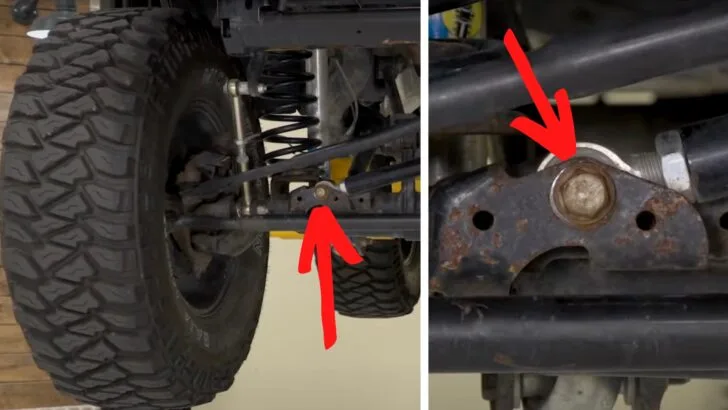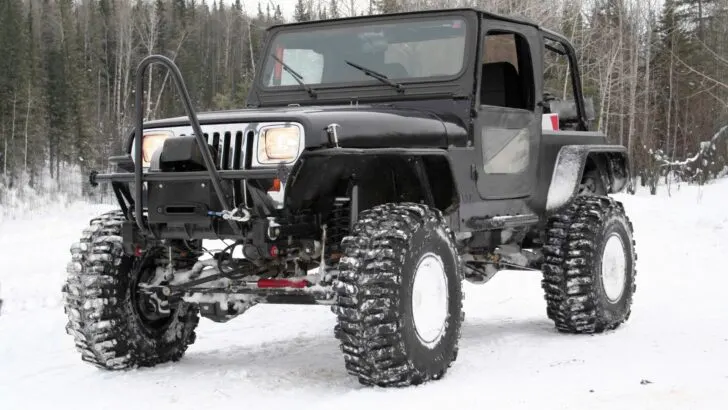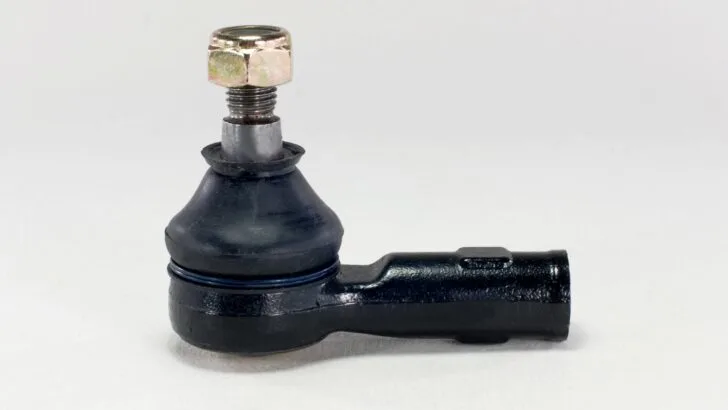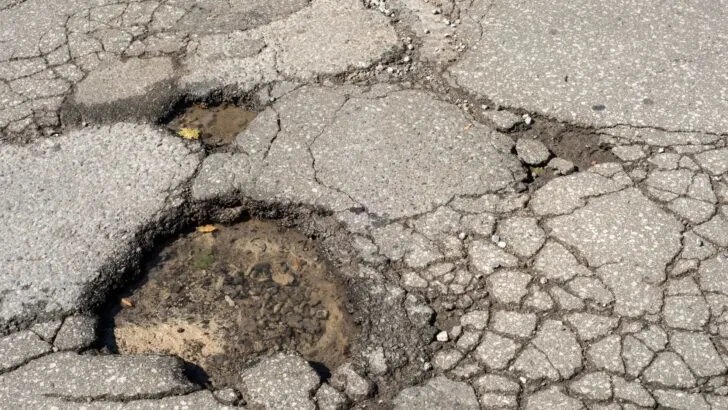Have you ever heard people’s descriptions of the Jeep death wobble?
“Uncontrollable shaking.”
“The epitome of white-knuckle driving.”
“Terror on the road.”
But, what causes the so-called “Jeep death wobble”? What should you do if you experience it? And is there a way to fix it? In this post, we’re looking at the death wobble Jeep has developed a reputation for providing for some unfortunate Jeep owners.
- 1) What Is the Jeep Death Wobble?
- 2) Is Death Wobble Limited Only to Jeeps?
-
3)
What Causes Death Wobble?
- 3.1) Loose Track Bar Bolt
- 3.2) Lift/Lift Kit to Modify 4WD Jeeps
- 3.3) Loose or Damaged Suspension or Steering Components
- 3.4) Poorly Installed Steering or Suspension Components
- 3.5) Improper Alignment
- 3.6) Tire Pressure and Balance
- 3.7) Front Track Bar
- 3.8) Ball Joints
- 3.9) Steering Stabilizer or Damper
- 3.10) Excessive Wear
- 4) Can Death Wobble Spontaneously Occur in Any Vehicle?
- 5) Do All Jeeps Have the Death Wobble?
- 6) How Many Deaths Have Occurred from Jeep Death Wobble?
- 7) What to Do If You Experience Death Wobble
- 8) How Can I Prevent the Death Wobble?
- 9) How Do You Fix Death Wobble in a Jeep?
- 10) Will Jeep Fix Death Wobble for Free?
- 11) Have You Ever Experienced Death Wobble?
- 12) Free RVing Tips, Tricks, Reviews, Giveaways & More
What Is the Jeep Death Wobble?
“Jeep death wobble” is a phrase heard time and again from Jeep owners, with Jeep Wrangler death wobble being the most commonly-reported experience.
“Death wobble” refers to the uncontrollable violent shaking of the vehicle. Instances of death wobble find the steering wheel moving quickly from side to side with the wheels vibrating similarly, causing the entire vehicle to shake violently.
As you might expect, when this occurs the driver experiences a sudden loss of control of the vehicle.
Death wobble is most often experienced at speeds over 40 mph, but it can occur at any speed. It’s most alarming and most dangerous at highway speeds, and can occur whether you’re driving it, or flat-towing behind your motorhome.
Is Death Wobble Limited Only to Jeeps?
No, death wobble is not limited to Jeeps. In addition to Jeeps, death wobble most often occurs in trucks and 4-wheel-drive vehicles, but it could conceivably happen in other vehicles as well. Any solid front axle vehicle COULD experience death wobble.
Let’s take a look at the common causes of death wobble to see why.
What Causes Death Wobble?
Any number of issues can cause death wobble in a vehicle. Generally speaking, these causes can be described as loose or damaged steering (or suspension) components. But, the following are the most likely causes.
Loose Track Bar Bolt
In many cases, the cause of death wobble is a loose or poorly fitting track bar bolt.

A track bar bolt needs to be extremely tight. Sometimes death wobble is simply due to this both being loose. But there may also be other causes as well. (Photo source: ExtremeTerrain)
In this case, tightening or replacing the bolt may correct the issue. (A track bar bolt needs to be extremely tight!)
However, there are many other issues that may be at play, and we want to cover all of those as well.
Lift/Lift Kit to Modify 4WD Jeeps
Interestingly, one of the most common causes of death wobble seems to be related to the modification of 4-wheel-drive vehicles (like the Jeep Wrangler). In particular, some Jeep owners add stronger springs and suspension components (and/or specialized lift kits) to modify their Jeeps for a different look and feel.
While it’s true that some modifications like these can make a vehicle perform better in rugged off-road conditions, they can also be the cause of death wobble due to the change in suspension configuration.
It’s a common theory that these modifications, in addition to the fact that the Jeep Wrangler comes from the factory with a solid front axle, are why the experience of death wobble is so common in these particular vehicles.
Loose or Damaged Suspension or Steering Components
Death wobble is frequently attributed to loose, worn, or damaged steering components, suspension components, or a combination of both.
Poorly Installed Steering or Suspension Components
Steering and/or suspension components can also be improperly installed, leading to issues that create death wobble. These may include such components as tie rods, tie rod ends, and wheel bearings.
For example, some Jeep owners replace their stock tires with large off-road tires. This increases the stress on stock tie rods.

Some Jeep owners replace their stock tires with large off-road tires increasing the stress on stock tie rods.
Tie rods are an essential part of your vehicle’s steering system. Located on each front wheel, a tie rod connects the steering gear to the steering knuckle. Tie rods are also responsible for moving the input from the drag link to the wheels.
If tie rods are worn, stressed, or bent, this is very likely to cause tire wear and handling problems, potentially leading to something as extreme as death wobble.
Improper Alignment
Steering that’s out of alignment can also be the cause of death wobble. As steering components wear out over time, they get loose, bend, or even break. This will impact the alignment of the vehicle.
We mentioned modifications earlier, including lift kits. Lift kits change the configuration of the suspension which is also likely to throw the steering out of alignment.
No matter the reason, though, if a vehicle is out of alignment, a death wobble can result, particularly at higher speeds.
Tire Pressure and Balance
We’ve written about RV tire pressure on this blog more than once. We even took the time to write an e-book on the topic and offer it free to our subscribers because we know that tire pressure is more important than many people realize.
And the truth is that many drivers don’t know how to properly check & set their vehicle’s tire pressure, so this is a pretty common issue.
In some vehicles, including Jeeps, over-inflation or under-inflation of tires can lead to death wobble. In fact, uneven tire pressures across all tires can trigger death wobble in some vehicles. The weight proportions of tires change as they wear and this will cause tires to become imbalanced. When this occurs on the front wheels in particular, it can lead to death wobble.
Death wobble can also result from unbalanced wheels, which is why new wheels and/or tires need to be professionally and dynamically balanced.
Front Track Bar
We talked about the track bar bolt at the beginning of this section. Let’s look a bit deeper into the track bar and how it can figure into death wobble in other ways.
The condition of the track bar is very important to both the steering and suspension of a vehicle. Its purpose is to accurately place the front axle under the vehicle while also properly configuring the suspension.
The track bar attaches to one end of the frame of the vehicle, across from the axle. Due to its location, it can take on some pretty heavy loads while the steering and suspension are at work.
There are mounting holes and bracket welds in the track bar that can become damaged in this process over time, as well as a number of bushings and bolts. Issues of wear or damage with any of these related components can contribute to the development of death wobble.
Ball Joints
Between the wheel knuckles and the vehicle’s suspension, there’s a ball joint.

A ball joint (hidden under the rubber covering on the left) connects to the top and bottom of a spindle. The tie rod end (extending to the right) connects to the spindle and controls its pivot. This allows a vehicle to be steered.
Ball joints are bearings that function in a similar fashion to human ball-and-socket joints (like your shoulders and hips). They connect the control arms of the vehicle’s suspension to the steering knuckles.
Because ball joints handle the load of the vehicle and the force of its movement, when they wear out it can allow the tires of the vehicle to move in a wild, uncontrolled manner.
And as we mentioned earlier, some Jeep owners opt for larger wheels and tires. However, if they don’t get the ball joints of the vehicle replaced/upgraded as well, the stock ball joints are likely to be damaged, and this can also result in death wobble.
Steering Stabilizer or Damper
The job of a steering stabilizer or steering damper is to dampen the movement in the steering system. The damper/stabilizer absorbs movement and vibrations, such as those that can trigger death wobble.
If a steering damper/stabilizer wears out (or again, if the vehicle owner opts for larger wheels), the damper/stabilizer takes on excessive pressure which can lead to death wobble.
In addition to all of that, a worn steering damper/stabilizer can lead to other steering components being damaged, and this type of damage and wear can also lead to death wobble.
Excessive Wear
And finally, death wobble itself can cause the mounting bolts that hold the suspension components in place to become worn or loose. This, and any bent or damaged components can all lead to a worsening death wobble.
Mounting bolts can even break loose from the frame which would certainly contribute to the occurrence of death wobble. The same is true of shocks and wheel bearings that have suffered excessive wear.
All of this means that once you’ve experienced death wobble in a vehicle, it’s very likely to happen again.
Can Death Wobble Spontaneously Occur in Any Vehicle?
Death wobble doesn’t generally just happen. Usually, an event such as hitting a pothole or a bump at the proper speed will trigger violent shaking.

An event generally has to trigger death wobble, such as hitting a bump or a pothole in the road.
And death wobble doesn’t only occur in Jeeps, it tends to also affect vehicles with a solid front axle such as trucks and other 4-wheel-drive vehicles.
The reason for this is that it’s difficult for a vehicle with a solid front axle to absorb the shock of hitting that pothole or bump.
Do All Jeeps Have the Death Wobble?
Jeeps that have been modified and the Jeep Wrangler and Gladiator are the most likely Jeeps to experience death wobble. With that said, there have been reports of death wobble in virtually every model and year of Jeep, so it appears that all Jeeps are susceptible to the death wobble.
But no, not all Jeeps have the death wobble!
In fact, despite the class action lawsuit currently ongoing, there have only been around 700 reports of death wobble in Jeeps since 1995.
However, if you’re a Jeep owner who has never experienced death wobble, it doesn’t mean you never will. Some experts even say that it’s not a matter of IF a Jeep owner will experience death wobble, but WHEN it will occur.
Again, worn components such as control arms and suspension parts, tire inflation and balance issues, wheel alignment, and modifications increase the likelihood that you’ll experience death wobble in your Jeep.
How Many Deaths Have Occurred from Jeep Death Wobble?
Zero. To date (February 2023), no deaths have been attributed to the Jeep death wobble, though there have been some accidents and injuries that have resulted.
Death wobble is a serious concern for sure. However, it generally occurs because some component of the individual Jeep needs attention. Once the issue has been addressed, the Jeep should perform as intended.
What to Do If You Experience Death Wobble
The best thing one can do is to prepare in advance for the violent shaking that occurs, so that if/when it happens, you can try to remember what actions to take to remain safe.
Your main goal is to slow the vehicle down, pull over, and come to a stop. As you’re working toward that goal, keep the following points in mind in an effort to avoid an accident:
- Don’t let go of the steering wheel
- Hold the steering wheel in the learner’s position (10 & 2 ) with a light grip
- Decrease your speed by letting up on the gas
- If you need to use your brake, do so only very lightly
Note that in most cases, slowing down by decelerating (not slamming on the brakes!) will stop the death wobble.
Never attempt to pull over at high speed while engaged in a death wobble, and try to avoid moving into another lane. Sudden, jerky movements by a driver in the midst of death wobble, especially at high speeds, could cause the vehicle to flip over.
How Can I Prevent the Death Wobble?
Here’s a list of things you can do to lessen the likelihood that you’ll experience death wobble in any vehicle:
- Don’t modify your Jeep without professional assistance to make sure all components are up to handling the load
- Don’t modify or DIY repair your Jeep’s suspension or steering – hire a pro!
- Keep all maintenance up to date and repair any issues immediately
- Maintain the correct tire pressure and balance
- Have the wheels of your Jeep aligned
- Have your Jeep’s suspension system inspected regularly
How Do You Fix Death Wobble in a Jeep?
In addition to tending to all of the potential causes noted throughout this post, we suggest watching the following video.
In the early portion of the video, you’ll see a demonstration of what death wobble is, how it occurs, and how to handle the situation if it occurs.
In the second half of the video, you’ll be given a clear visual perspective on how to fix death wobble in a Jeep.
Will Jeep Fix Death Wobble for Free?
According to a report by the Detroit Free Press in August of 2019, Jeep’s parent company (Fiat Chrysler Automobiles) issued a statement in response to the class action lawsuit filed by Jeep Wrangler owners. (Here’s the settlement information on that lawsuit.)
The statement notes that Jeep will replace the steering damper (a stabilizing component) with a new component that is more capable of handling vibrations coming from the front suspension.
The lawsuit, however, notes that the replacement of the steering damper is a temporary fix at best. More importantly, because there are so many potential causes of death wobble, it’s hard to know whether Jeep’s repair (Band Aid?!?) will mitigate the problem much if at all.
If you’re entitled to the potential fix being offered by Jeep, however, it’s most certainly worth having it addressed at no cost to you.
Have You Ever Experienced Death Wobble?
If you’ve ever experienced death wobble, we’d like to hear from you. Tell us about what you were driving and what you believe was the cause of the death wobble you experienced. How’d you handle the situation and how did it resolve?
Drop us a comment!
Free RVing Tips, Tricks, Reviews, Giveaways & More
Subscribe to our daily newsletter! We’ve been full-time RVers for 20 years (!) and share everything we’ve learned about RVing in our daily blog posts. Join our online community to receive a wealth of great RVing knowledge delivered right to your inbox.
Whether this is your first time on the road or you’re a seasoned full-timer, you’ll love the wide range of RVing topics we cover. Don’t miss a single article or any of our famous RV gear Giveaways — Subscribe today!


Paul Meier
Tuesday 20th of February 2024
I bought my cousins 2005 Wrangler from his estate with low miles. It handled well for about a year and then the shake began. Couldn't tell where it was coming from so asked a neighbor who had and worked on Jeeps and he gave me a list of might bes! Since it was used and I was going to replace tires and shocks decided to also do the track bar and bushings. Its been driving like new ever since.
Sarah Wierman
Thursday 21st of December 2023
My dad passed away last year and I inherited his 2020 Jeep Gladiator. He didn’t drive it much and it only had 14,000 miles under its belt. A weeks after I started driving it, I thought I blew a tire as the car started shaking violently on the road. It was terrifying as I was on the freeway and there was not a good place to pull off. Two weeks later, on a road trip to Monterey from LA, it happened over and over again. I was driving in the cool morning weather, and the cooler weather seems to have a part in this as I didn’t have a wobble on the way home when it warmed up a bit. I have been waiting for months for the dealership to get the right parts in, which they seem to have problems doing. I now have the wobble driving in town from time to time at very low speeds. My last big one was so bad that the 2 cars behind me also pulled off the road to make sure I was okay. Stew dealership called today to say they didn’t receive the right part and I’m fine to pick up my Jeep tomorrow. I literally can’t believe they think it’s okay to drive. I’m at a loss and not sure what to do now. They said it is in back order and could be a few more months until it arrives. Of course, it’s winter and the temps are ripe for the wobble.
Frine Longueira
Tuesday 19th of December 2023
I purchases my brand new 2022 Jeep Wrangler Sport in July of 2023. I have experienced the death wobble more times than I care to remember. I am still trying to get the dealership to do something about it.
Gayle
Saturday 25th of November 2023
We were on our way back from vacation and felt the first wobble in our 2022 Wrangler. We thought it was a flat, which it wasn’t. But we did notice we were missing a lug nut. We replaced that and headed out only to experience another wobble. We found a Les Schwab and they determined balancing wasn’t needed but they did rotate the tires. We learned this didn’t fix the problem either. Back on the road we are driving no faster than 68mph. This seems to be a safe speed BUT we definitely feel a wobble when changing lanes and driving over tougher pavement. We have NEVER experienced this until this trip. We are hoping this is covered with our warranty.
TheRVgeeks
Monday 27th of November 2023
Oh no Gayle, sorry to hear about your experience. We hope Jeep's able to take care of you... and please let us know if they do! 🤞🤞
Robert
Thursday 2nd of November 2023
I drive a 2022 Jeep Gladiator that has had a death wobble problem since I first got it brand new.The first time it happened I thought I had blown a tire and I immediately pulled over on the freeway to inspect which tire. But of course, it wasnt a tire. I have learned how to deal with it which is to sense the first vibrations and taking my foor off of the gas peddle. However, it is getting worse now that I have put 30,000 miles on it. Now the slightest bump, like changing lanes can cause serious wobbling. I can't believe that no one informed me of this (or the jeep wave) when I purchased my Jeep. This seems like serious lack of good judgment on Jeeps part.
TheRVgeeks
Thursday 2nd of November 2023
Oh no, Robert. So sorry to hear about that! We agree... seems like the kind of thing that should've been addressed by now. Hard to believe that NHTSA hasn't forced them to recall and repair every model ever affected! This is a serious safety issue, and they're sweeping it under the carpet.